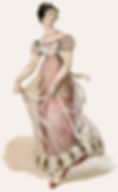When you hear regency, do you think of that awesome sub-genre of a billion-dollar publishing industry? Regency romances tend to be dialogue heavy, with an independent heroine—often appearing modern—in a highly restrictive society preoccupied with behavior and reputation. Traditional regency romances might be more Heyer-like, and modern regencies can be bolder and sexier.
I blog about aspects of Regency England life and how it connects to the regency-set Austenesque romances I write, but what does "regency" in this context even mean?

The Regency era in England refers to a subset of the Georgian era (1714-1837). It’s a political period from 1811 to 1820 when George, Prince of Wales, governed the country after his father George III became permanently disabled. George III had an episode of mental illness in 1788, but before parliament could debate a bill establishing a regency act, the King recovered. But following the death of his youngest daughter, Princess Amelia, in 1810, he became permanently disabled and the Regency Act of 1811 was passed.
Nine years. Technically, that’s it. That's the whole Regency. He ruled as regent until 1820 when, on his father's death, he assumed the title George IV and reigned until his death in 1830.
However, the Regency period has come to include the early years of the nineteenth century and its broader meaning includes not just the politics but the entire era's social values. Some even include the late 1790s all the way to the start of Victoria’s reign in 1837 in this "Regency period."

This is partly because the Prince Regent encouraged the development of arts and sciences both during this period and before he became regent. The Royal Pavilion, and surrounding gardens, in Brighton, was built as his seaside retreat. It’s a lavishly furnished and decorated home that epitomized the splendor of the era as well as its excesses.
The Prince Regent lived a life of dissipation and extravagance involving heavy drinking and numerous mistresses. He showed good but expensive taste in decorating his palace. He was said to be clever and knowledgeable, but his laziness and gluttony led him to squander his talents.
His interests influenced everything from plays to clothes. He was a patron of arts, architecture, literature, and music—even though by the time he ruled as regent his extravagance made him lose the popularity he enjoyed as a young man. The Regency period saw a shift in fashion that was partially determined by the Prince Regent. After political opponents taxed wig powered in 1795, he abandoned wearing a powdered wig in favor of natural hair. Without discounting Beau Brummel’s influence, the Prince Regent wore darker colors than had been previously fashionable as they helped to disguise his size and preferred pantaloons and trousers over knee breeches because they were looser.
But in many ways this 1790s-1820s era stands on its own aside from the Regent himself because the end of the Georgian era to the beginning of the Victorian one was one of particularly great social, political, and economic change.
Britain was engaged almost nonstop in the Revolutionary and Napoleonic Wars of 1793–1815. This led to financial instability and monetary volatility. Britain’s war with France affected every level of British society. An estimated quarter of a million served in the regular army and a militia of officers and volunteers mobilized for what was feared to be an impending invasion by Napoleon. This long-running conflict had a significant impact on both daily life and politics, on supplies, prices, culture, and literature.

There was mass unemployment following the wars and, in 1816, an exceptionally bad harvest worsened by the Corn Laws kept the price of bread high. In addition, Britain underwent a population boom, and the combination of these factors resulted in widespread poverty.
The regency era also saw the beginning of industrialization in England. There were food riots and Luddite protestors engaged in machine breaking. Suffrage reform was present but slow; at that time only around 11 percent of adult males could vote. Eighteen people were killed and several hundred injured in 1819 in what became known as the Peterloo massacre. The cavalry rode into a crowd of tens of thousands of people who had gathered to demand the reform of parliamentary representation.
We tend to think of visiting the theatre during the season in a highly stratified society when we think "regency era", but this period also saw a side that’s often missing from regency romances. Women’s rights, wealth inequality, and child labor were just some of the other issues present among the boom of novels, art, and industrialization.
In addition to the bloodshed and 20 years of war, the Regency was a period of artistic achievement as upper class society flourished in a cultural Renaissance amid the Romantic movement. But, slowly, the excesses of the aristocracy and freewheeling lifestyles waned, and the outwardly strict Victorian moral code replaced it. The Regency era’s prevailing social customs became codified to the extreme and its neo-classical simplicity gave way to the heavy ornamentation we associate with the latter half of the century.

There were distinctive trends in British architecture, literature, fashions, politics, and culture that were unique to this time. All of these things make the Regency era—whether you look at 1811-1820 or take a broader view of the late 18th century through the 1830s—a significant and emotionally resonant era and a great time period for historical fiction.
What do you think of when you hear ‘regency’? When you read a regency-set story, what qualities, experiences, or history do you hope to see?